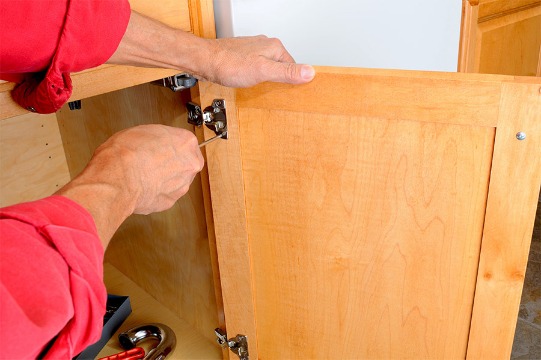On the disadvantage, the procedure can generate a lot of moisture and saturate wood. Heat removing resembles a tango between the hand holding the heating unit and the one with the scraper. Hover the device over the surface. When the paint bubbles, gradually move the heating system along and try to develop a rhythm so that you're scraping and heating up in unison.
If you're going to utilize a chemical stripper, know that anything that eats paint threatens which doing the job without methylene chloride (see above) will be safer however slower. These wood stripping items consist of less poisonous, less poisonous active ingredients and remove both latex and oil paints. A paste with a frosting-like consistency that can be brushed, rolled, or sprayed on - Cabinet Painters 28210.
Benzyl alcohol One coat eliminates up to 15 layers of paint. 3 to 24 hours Remove the paint, scrub off the residue with a wet nylon brush, and wash with water. Cabinet Painting. about $65 per gallon This paste works with a paper cover to manage evaporation. Suitable for lead paint and masonry, however can stain furnishings woods.
Unknown Facts About 2022 Average Cabinet Refinishing Cost - content Residential Painting.Contractors - 704-931-8438(With Price Factors)


12 to 24 hours Remove the paper and scrub the surface with a damp brush; let dry thoroughly, then use a neutralizing solution. about $45 per 1 gallons This wood stripper is an orange gel, best on furniture details and flat surface areas since it is thin. N-Methyl-2-pyrrolidone (NMP) A -inch coat gets rid of as much as 7 layers of paint.
about $20 per half gallon Years earlier, if you required a fast-acting chemical paint stripper, you chose a product that included a seriously poisonous chemical called methylene chloride (likewise called dichloromethane, or DCM), cranked up the fan, and finished the job rapidly. Cabinet Painters 28210. Typically speaking, the much faster a chemical eats through paint and surface, the more hazardous it is, and DCM is fastpaint starts to bubble in minutes.
Prolonged direct exposure to DCM, through the lungs or skin, has been connected to liver damage, cancer, and even death. The vapors can overwhelm air-purifying respirators, and simply a couple of whiffs can leave you wheezing and woozy. Europe prohibited it for domestic usage in 2010. While DCM-containing paint strippers are still extensively sold in the U.S., the Centers for Illness Control and Avoidance has connected the ingredient to 13 deaths in 10 states.
Not known Details About An Easier Way To Remove Paint From Wood - Residential Painting.Contractors - Cabinet Painting Tips


No paint-stripping venture is total without an arsenal of scrapers to usher away softened paint. A 5-in-1 paint scraperalso known as the "painter's tool" since the curved edge can be used to clean up a paint rolleris the go-to tool for removing most kinds of paint. Metal pull scrapers come with changeable blade profiles to match the surface you require to strip, providing more control than push scrapers in tight spots or on great details.
After that, replace or resharpen the blades. "Keep a hand file nearby to rapidly restore the edge of a steel scraper," states TOH basic contractor Tom Silva. "Brace the scraper versus a flat surface area, attempt to follow the initial bevel, and constantly file in the exact same instructions." Carbide blades hold an edge much longer than steel, however resharpening requires a diamond stone and some skill.

When using push scrapers, choose plastic over metal, to prevent gouging; this is particularly crucial with chemical strippers, which can soften wood. Almost 90 percent of homes constructed prior to 1940 have some paint packed with this poisonous metal. Although its usage went into high decrease after 1950, lead-based paint wasn't banned in the U.S.
The Basic Principles Of How To Remove Paint From Nearly Any Surface - Diy ...
Here's how to detect it. Use an utility knife to make a V-shaped cut through all the layers of paint, then brush the groove with a LeadCheck swab. A bright red color shows lead exists. Scrape a table-spoon of chips into a bag and send them to a laboratory for testing.
For a few hundred dollars, a licensed lead inspector will carry out an X-ray fluorescence test to identify the quantity of lead present in all the painted surfaces in your home. Lead is nasty. Direct exposure can raise your high blood pressure, tension your nerve system, and damage your memory, among other risks. Cabinet Painting Contractors 28213.
If you wish to eliminate lead-based paint yourself, in addition to the gown and prep steps (next), follow these precautions: Usage just heat or chemicals to avoid kicking up lead-laced chips and dust If you need to sand, usage equipment fitted with a shroud and a HEPA vacuum attachment. Wet-sand removed surfaces to reduce dust.
The 5-Second Trick For Can Old Wood Cabinets Be Painted? - Residential Painting.Contractors - Refinishing Old Cabinets Correctly...
Location particles in professional bags; seal with duct tape. Discover more beneficial suggestions at www2.epa.gov/ lead. Avoid canvas drop fabrics in favor of 6-mil plastic sheeting, which will not trap great grit or let chemicals seep through. Extend the sheeting at least 6 feet beyond the workspace and overlap and tape the edges.